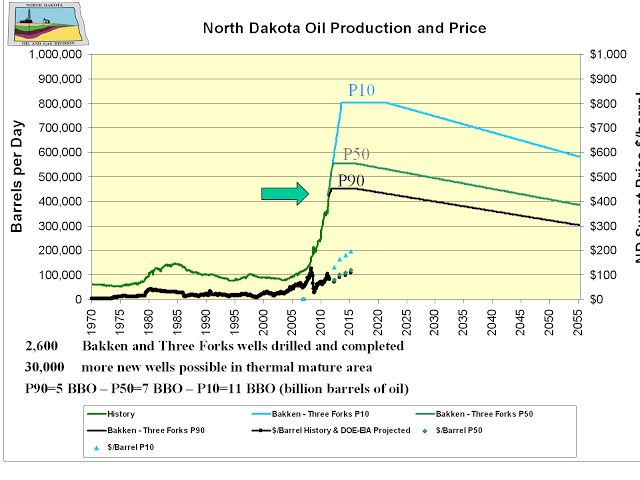US crude oil production could increase by 500,000 to 1 million barrels per day each year through 2015 driven by North Dakota oil, Eagle Ford in Texas and Utica Shale.
North Dakota Bakken County Oil Update Lynn Helms (18 MB, power point -pptx) The presentation where Lynn Helms talks about the boom in North Dakota oil.
2011 North Dakota Association of Oil and Gas Producing Counties annual meeting in Medora, North Dakota.
Oil Wells drilled are increasing to 2000 per year (about double the rate of prior years.) Lynn also indicated the potential of the Tyler Formation.
The P10 scenario where there is 10 billion barrels of oil in place looks like it takes to 2013 to ramp up to that level.
With 150,000 barrels per day added in ND in 2012 and another similar amount in Eagle Ford.
Chesapeake Energy (major Utica Shale player) expects to increase its net liquids production by 50%, to more than 150,000 barrels a day by the end of 2012. By the end of 2015, the company expects to increase its liquids production by 150%, climbing to more than 250,000 barrels a day. Chesapeake plans to boost its rig count in the Utica shale to 10 by the end of 2011, double the current number, and said it’ll be drilling with 20 rigs by the end of 2012 and with up to 40 by the end of 2014.
And some more oil coming online in the gulf and other locations
US crude oil production could go from 5.8 million bpd to 6.5-7 million barrels per day in 2012.
US Crude oil production for the week of Sept 30, 2011 was 5.8 million bpd. This has been an increase of 300,000 bpd from last year. Net oil imports were down to 8.66 mbd and total oil (fossil fuel liquids) used was 19.1 mbd. 15.1 mbd went to crude oil refineries.
4.1 mbd of other non-crude oil supply
2.2 mbd natural gas liquids
0.9 mbd renewable fuels
0.9 mbd ethanol
1.1 mbd refinery process gain
US crude oil production could go to 7-7.5 million barrels per day in 2013.
US crude oil production could optimistically increase by 1 million barrels per day through 2015 (a more conservative but realitistic projection is an increase of 500,000 barrels per day), which would put crude oil production in the range of Russia and Saudi Arabia. The United States could definitely be leading in liquid fuel production when the ethanol and natural gas liquids is added.
The US could have 8-10 million bpd of crude oil production in 2015 and 11-14 million bpd of crude + natural gas liquids + biofuel/ethanol.
North Dakota should pass Alaska and California to be become the second biggest oil producing state after Texas in 2012 or 2013.
If Harold Hamm is correct (and he has made himself about 8 billion from oil in North Dakota) then North Dakota could reach well over 1 million barrels per day.
The estimates do not seem to be including the Tyler Formation (2-4 billion barrels of recoverable oil) or the Spearfish formation in North Dakota
Background
Understanding the reduced percentage of oil imports by the United States
US oil imports have shifted from 61-63% imports to 47% imports. 3.8 million barrels per day of lower oil imports but 1.8 million barrels per day is from lower oil usage. A lot of the lower oil usage is because of the higher prices for oil and a weaker economy.
Net imports of oil and fossil fuel liquids have decreased to 8.0 to 9.5 million barrels per day in 2010 and 2011 (average about 9.0 million barrel per day). From 2005 to 2007, the net imported crude oil and petroleum products was 12.0 to 13.3 million barrels per day (average about 12.8 million barrels per day)
The total petroleum supplied to the United States from 2005 to 2007 was 19.7 to 21.4 million barrels per day (average about 20.8 million barrels per day). In 2010 and 2011 the petroleum used has been 18.1 to 20.2 million barrels per day (average petroleum used has been 19.0 million barrels per day).
If you liked this article, please give it a quick review on ycombinator or StumbleUpon. Thanks

Brian Wang is a Futurist Thought Leader and a popular Science blogger with 1 million readers per month. His blog Nextbigfuture.com is ranked #1 Science News Blog. It covers many disruptive technology and trends including Space, Robotics, Artificial Intelligence, Medicine, Anti-aging Biotechnology, and Nanotechnology.
Known for identifying cutting edge technologies, he is currently a Co-Founder of a startup and fundraiser for high potential early-stage companies. He is the Head of Research for Allocations for deep technology investments and an Angel Investor at Space Angels.
A frequent speaker at corporations, he has been a TEDx speaker, a Singularity University speaker and guest at numerous interviews for radio and podcasts. He is open to public speaking and advising engagements.


